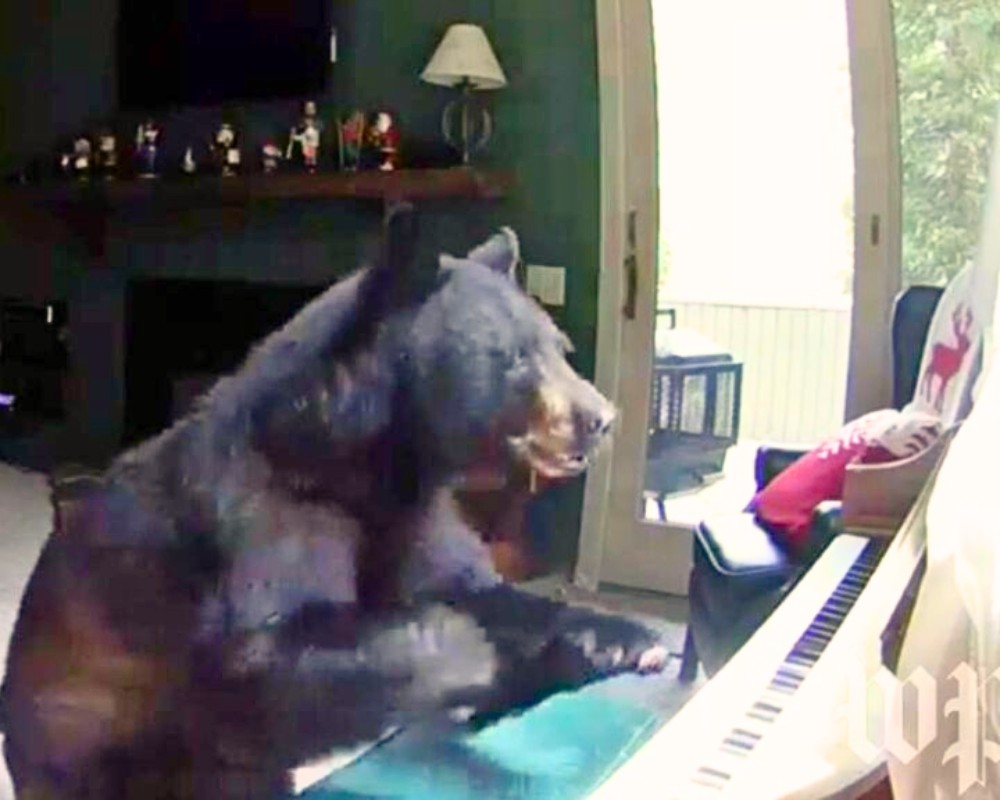In a surprising moment of wildlife curiosity, a black bear in Vail, Colorado, broke into a woman’s home—and ended up giving an unexpected piano performance before sneaking back into the woods. The bizarre incident, caught on home surveillance, left both residents and police stunned.
The animal, which entered through an open kitchen window, appeared to be searching for food. Instead, it explored the home, opened the refrigerator, and then paused to test its musical talent. For a few seconds, the wild visitor pawed at the piano keys, producing what police jokingly described as “unbearable chords.”
The Musical Intruder
Police were called to investigate a suspected burglary after the homeowner returned to find her kitchen in disarray and food missing. But when she checked her surveillance footage, she was astonished—the culprit wasn’t a thief in disguise but a large black bear.
The video showed the bear wandering around calmly, sniffing at shelves and drawers. Then it approached the living room piano and pressed a few keys, filling the room with random notes. Though not quite Beethoven, the moment became one of the most extraordinary examples of animals interacting with human objects.
Authorities humorously wrote in their report, “The chords were unbearable, and the tune equally grizzly.” While the wildlife encounter drew laughter online, it also raised questions about human–animal boundaries in suburban areas near forests.
Why Bears Enter Homes
Incidents like this aren’t uncommon in regions close to mountain wilderness. As human developments expand deeper into nature, wild bears and other animals often wander into neighborhoods in search of food. They are driven by instinct, not aggression.
Experts explain that bears have a strong sense of smell—up to seven times more powerful than a bloodhound. Even faint scents of leftover meals, pet food, or trash can lure them from miles away. Once they associate houses with food, they tend to return, creating potential danger for both animals and humans.
Colorado wildlife authorities repeatedly urge residents to secure windows, close doors, and use bear-proof trash bins. Feeding or leaving food accessible to wild animals is discouraged because it disrupts natural behavior and can lead to aggressive encounters.
Human Expansion vs. Wildlife Habitats
The bear’s piano “concert” may have been amusing, but it highlights a serious environmental issue. As more housing developments rise near forests and mountains, wild creatures are forced to adapt—or risk conflict. Many animals, from bears to deer and raccoons, are simply exploring spaces that used to be theirs.
Environmental experts emphasize that these interactions should remind humans of the balance needed between urban living and nature preservation. When people build homes in forested regions, they must take responsibility to coexist respectfully with local wildlife.
This includes storing food properly, minimizing waste scents, and never leaving windows open in bear-prone areas. Doing so protects both humans and the animals seeking survival.
The Online Reaction
Once the video surfaced, it quickly went viral, drawing millions of views across social media platforms. Many users found it hilarious—one commenter joked, “The bear’s next concert is already sold out.” Others, however, pointed out that the situation could have turned dangerous if someone had been home.
Police confirmed that despite the humor, the incident served as an important reminder about securing homes in areas bordering wilderness zones. They also stated that “the suspect is still at large,” maintaining the lighthearted tone of the report.
A Lesson in Coexistence
While bears breaking into homes might seem alarming, most are not violent by nature. They are opportunists seeking nourishment or curiosity. Biologists note that punishing or harming these creatures doesn’t solve the root issue. Instead, communities should focus on preventive strategies and public education about animal behavior.
As one wildlife officer said, “Bears are not intruders—they’re residents of the land we moved into.” Recognizing this truth can transform fear into understanding, leading to safer coexistence between people and the wildlife that surrounds them.
Final Thoughts
The Vail bear’s short piano recital might have been comedic, but it also symbolized something deeper: nature’s constant reminder that it’s still very much alive, even in our human spaces. These animals don’t mean harm—they adapt to survive in an environment increasingly dominated by people.
As this story proves, the boundary between civilization and nature is thinner than we think. A single open window can turn into a concert hall for the wild, and sometimes, that harmony—however chaotic—is what connects us most deeply to the living world around us.


